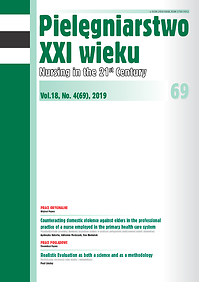Counteracting domestic violence against elders in the professional practice of a nurse employed in the primary health care system
DOI:
https://doi.org/10.2478/pielxxiw-2019-0032Keywords:
nurse, prevention, elder abuseAbstract
COUNTERACTING DOMESTIC VIOLENCE AGAINST ELDERS IN THE PROFESSIONAL PRACTICE OF A NURSE EMPLOYED IN THE PRIMARY HEALTH CARE SYSTEM
Aim. Assessment of preparation of a nurse – employee of the primary health care for providing preventative measures against domestic violence targeted at elders.
Material and methods. The material was collected in a group of 70 nurses – employees of the primary health care of a medical centre in Lodz. Inclusion criteria were: the respondent’s consent for the inclusion in the study and the position of a nurse of the primary health care system. The authors of the study used the diagnostic survey method, with the application of their own questionnaire. Obtained results were statistically analysed.
Results. In the nurses’ opinion, lack of knowledge of effective tools, which could be used to provide victims with help, considerably hampers implementation of preventive measures for counteracting domestic violence. A multivariate analysis revealed a relationship between the opinion of nurses on prevention of domestic violence against the elderly and their education, the number of years worked and individual beliefs.
Conclusions. Violence against elders is a growing global problem. Polish nurses are legally obliged to initiate interventions in order to counteract domestic violence. Nurses from the primary health care are not prepared to carry out prevention of violence against the elderly. There is a need to provide nurses employed in the primary health care with post-graduate training on counteracting domestic violence against the elderly.
References
1. Pillemer K, Burnes D, Riffin C et al. Lachs MS. Elder Abuse: Global Situation, Risk Factors, and Prevention Strategies. The Gerontologist. 2016;56 (2):194-205. Cytowany dn. 25.04.2019r.
2. Yon Y, Mikton CHR, Gassoumis ZD. Elder abuse prevalence in community settings: a systematic review and meta-analysis. Lancet Glob Health. 2017;5 (2):147-156. Cytowany dn. 25.04.2019r.
3. WHO (2017). Elder Abouse. Fact Sheet. Cytowany dn. 25.04.2019r.
4. Ustawa z dnia 29 lipca 2005 r. o przeciwdziałaniu przemocy w rodzinie tekst ujednolicony (Dz. U. z 2005 r. nr 180, poz.1493, z 2009 r. nr 206, poz. 1589, z 2010 r. nr 28, poz. 146, nr 125, poz. 842, z 2011 r. nr 149, poz. 887).
5. Rozporządzenie Rady Ministrów z dnia 13 września 2011 r. w sprawie procedury „Niebieskiej Karty” oraz wzorów formularzy „Niebieska Karta” (Dz. U. z 2010 r. nr 209, poz. 1245).
6. Marcinowicz L. Rola pielęgniarki i położnej w sprawowaniu podstawowej opieki zdrowotnej. Zdr Pub i Zarządzanie. 2014;12(4): 352-357.
7. Korzeniowski K, Radkiewicz P. Przemoc w rodzinie wobec osób starszych i niepełnosprawnych. Raport z badania ogólnopolskiego 2015r. oraz badania porównawczego z lat 2009-2015. Warszawa: PAN. Cytowany dn. 04.06.2019r. https://www.gov.pl/documents/1048151/1060973/DPS
8. Leszko M. Przejawy przemocy wobec osób starszych-definicja i występowanie [w:] Muszalik M, Kędziora-Kornatowska K, red. Pielęgnowanie pacjentów w starszym wieku. Warszawa: PZWL; 2018, s. 85-94.
9. Mordawska J. Zjawisko przemocy wobec osób starszych: skala problemu, czynniki ryzyka, metody przeciwdziałania [w:] Lewicka-Zelent A, Maciąg K, red. Osoba doświadczająca przemocy w świecie milczenia czy wsparcia?: refleksje interpersonalne. Lublin: TYGIEL; 2017, s.126-137
10. Śniegulska A. Przemoc wobec kobiet i osób starszych w środowisku rodziny. JoMS. 2016;4(31):101-124. Cytowany dn. 04.06.2019r.
11. Pawłowska-Muc AK, Łepecka-Klusek C, Stadnicka G i wsp. Problem przemocy domowej w praktyce zawodowej pielęgniarek i położnych. Journal of Education, Health and Sport. 2017;7(4):38-50. Cytowany dn. 04.06.2019r.
12. Łepecka-Klusek C, Pawłowska-Muc AK, Stadnicka G i wsp. Przemoc domowa wobec kobiet. Med Og Nauki Zdr. 2015; 21(4): 408-413.
13. Mirczak A, Tobiasz-Adamczyk B, Brzyski P i wsp. Rozpoznawanie zjawiska przemocy wobec osób starszych przez pielęgniarki środowiskowe. Probl Piel. 2011;19 (2): 202-209.
14. Austin G, Rinker J. Recognition and perception of elder abuse by prehospital and hospital-basedcare providers. Arch. Gerontol. Geriatr. 2009;48:110-115. Cytowany dn. 04.06.2019r.
15. Truong C, Burnes D, Alaggia R et al. Disclosure among victims of elder abuse in healthcare settings: a missing piece in the overall effort toward detection. J Elder Abuse Negl. 2019;31 (2):181-190. Cytowany dn. 04.06.2019r.
16. Ahmed A, Choo WY, Othman S et al. Understanding of elder abuse and neglect among health care professionals in Malaysia: An exploratory survey. J Elder Abuse Negl. 2016;28 (3):163-77. Cytowany dn. 04.06.2019r.
17. Bidzińska E, Sobczak M, Rakowska K. Motywy podwyższania wykształcenia przez pielęgniarki Wojewódzkiego Szpitala Zespolonego w Elblągu. Probl Piel. 2007;15 (2):197-2002.
18. Chmielewska E. Wpływ czynników motywujących na kształcenie podyplomowe pielęgniarek w Wojewódzkim Szpitalu Specjalistycznym w Legnicy. Zeszyty Naukowe Państwowej Wyższej Szkoły Zawodowej im. Witelona w Legnicy. 2012;8: 19-33. Cytowany dn. 12.11.2019r.
19. Błazucka U, Ciślak H. Systemy motywacyjne w pracy pielęgniarki. Piel. Pol. 2015;3(57): 203-207. Cytowany dn. 12.11.2019r.
Published
Issue
Section
License
Copyright (c) 2019 Authors

This work is licensed under a Creative Commons Attribution-NonCommercial-NoDerivatives 3.0 Unported License.




